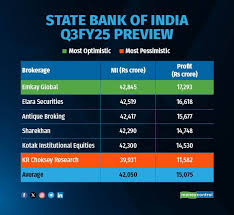State Bank of India Q3 2025 Results:
State Bank of India Q3 2025 Results: introduction
The State Bank of India (SBI), India’s largest public sector lender, reported its third-quarter results for FY 2025 on February 6, showcasing resilience despite macroeconomic uncertainties. The bank’s performance reflects strong operational efficiency, improved asset quality, and strategic prioritization of retail and digital growth. This article unpacks the key metrics, market reactions, and future projections shaping SBI’s trajectory 17.

2. Profit Surge: A Stellar 64–89% YoY Jump: State Bank of India Q3 2025 Results:
SBI’s net profit skyrocketed, with estimates ranging between ₹14,748 crore and ₹17,293 crore, marking a 61–89% YoY increase compared to ₹9,164 crore in Q3 FY24 46. This surge was driven by:
Reduced provisions: Loan loss provisions fell precipitously to ₹1,445 crore 10 (a 76.68% YoY decrease).
Operational efficiency: Cost-cutting initiatives, such as lower employee costs, increased revenue. 6.
Increased non-interest revenue: Retail banking and treasury fees increased 12.61% year over year.
Profits, however, fell 6–19% in a row, which was caused by growing deposit costs and seasonal pressures 49. State Bank of India Q3 2025 Results:
SBI’s Net Interest Income (NII) increased 6–8% YoY to ₹42,050–42,845 crore, driven by a 14% YoY expansion in loans (to ₹35–40 lakh crore). Revenue Growth: Steady but Margin Pressures Ahead 46. Important motivators included:
3. Revenue Growth: Consistent but Under Pressure from Margin With a 14% YoY

increased 6–8% YoY to ₹42,050–42,845 crore. 46. Among the main motivators were3. Revenue Growth: Consistent but Under Pressure from Margin With a 14% YoY increase in loans (to ₹35–40increase in loans (to ₹35–40 lakh crore), Loom SBI’s Net Interest Income (NII) lakh crore), Loom SBI’s Net Interest Income (NII) increased 6–8% YoY to ₹42,050–42,845 crore. 46. Among the main motivators were
Retail and MSME lending: Advances in these segments grew by 12–18% YoY 510.
Deposit growth: Deposits rose 9% YoY to ₹51.94 lakh crore, though lagging behind industry averages 4.
Net Interest Margins (NIMs), however, contracted to 3.1% (down 10 bps YoY) due to rising deposit rates outpacing lending yields 69.
4. Asset Quality: Maintaining Stability while Monitoring Slippages
With gross non-performing assets (NPAs) falling to 2.4% from 2.6% in Q2 of FY25, SBI’s asset quality improved. 1. Highlights consist of:
Decreased agricultural stress: Asset quality 9 was stabilized by fewer agribusiness defaults.
MTNL recognition: Higher YoY slippages 46 resulted from MTNL’s classification as an NPA.
Provisions under control: As a result of careful risk management, credit expenses stayed within reasonable bounds at 0.4%.
As recovery efforts pick up speed, analysts anticipate more gains in FY26 1.

5. Growth of the Loan Book: Retail Dominance Persists
State Bank of India Q3 2025 Results: A Comprehensive Analysis of Growth, Challenges, and Future Prospects
SBI’s loan book increased 14% year over year due to:
Retail loans: Personal and home loans increased by 12.3% 5.
Due to a resurgent demand for corporate credit, corporate lending has increased 18.35% yearly.
MSME focus: Loans to small businesses rose 17.36%, aligning with government initiatives 5.
The bank aims to sustain this momentum through digital lending platforms and tailored products 1.
6. Digital Push and Cost Management as Strategic Priorities
The management of SBI placed emphasis on three key pillars:
State Bank of India Q3 2025 Results: in the year
Digital transformation: Improving AI-powered services and mobile banking to increase consumer engagement 1.
Cost optimization: Branch simplification and automation assisted in lowering operating costs. 6.
7. Brokerage Insights: Cautious Bullish Targets
With price estimates ranging from ₹720 to ₹975, analysts are still optimistic:
Using a two-stage Gordon Growth Model and accounting for subsidiaries like as SBI Life and SBI Cards 3, Citi Research valued SBI at ₹720.
State Bank of India Q3 2025 Results:
Sharekhan: Citing robust loan growth and steady profitability, the company issued a “Buy” rating with a target of ₹975.
Nomura predicted an 86% year-over-year increase in profits, but noted margin concerns 9.
Slower deposit accretion and unsecured loan defaults are major dangers 69.
Focus on retail: Expanding reach in underbanked areas

8. Market Reaction and Future Outlook
Post-results, SBI’s stock traded flat, reflecting mixed sentiments. While shares have risen 18% over 12 months, they dipped 3% YTD due to broader market volatility 9.
FY25 Outlook:
Loan growth: Expected to sustain at 12–14% YoY, led by retail and corporate segments 6.
NIM stability: Margins likely to stabilize at 3.1–3.2% as deposit rates peak 9.
Asset quality: Further NPA reduction anticipated with economic recovery 1.
Challenges Ahead:
State Bank of India Q3 2025 Results:
State Bank of India Q3 2025 Results:
Rising competition in retail lending.
Global macroeconomic uncertainties impacting corporate credit demand.
Conclusion: State Bank of India Q3 2025 Results: SBI’s Balancing Act in a Volatile Era
SBI’s Q3 FY25 results underscore its ability to navigate challenges while capitalizing on India’s growth story. With robust profitability, improving asset quality, and a clear digital roadmap, the bank is well-positioned to maintain its leadership. However, margin pressures and evolving regulatory norms demand vigilant execution. For investors, SBI remains a cornerstone of India’s banking sector—a blend of stability and strategic agility 169.
[…] I can finance a home loan […]